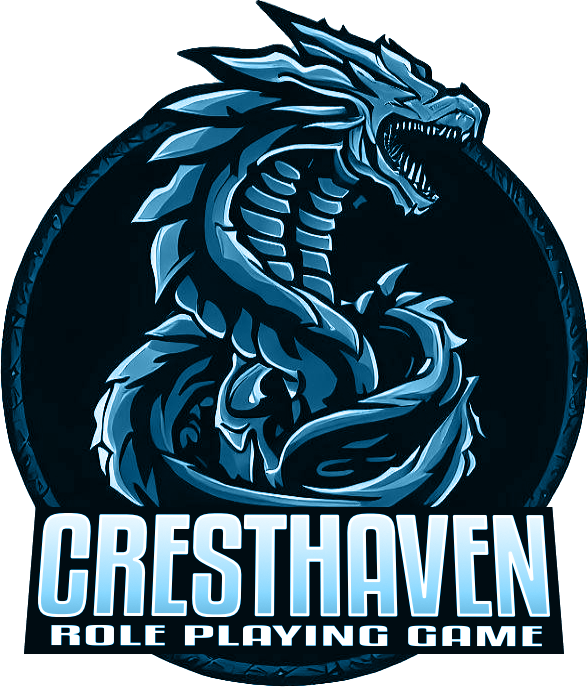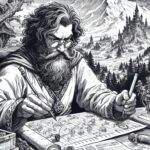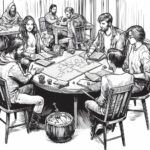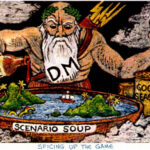One of the more important aspects of any role playing game is the ability to create your own adventures. When designing your adventure ask yourself this question:
Setting Goals
What is the goal? This is the most important question in any design of a dungeon. It will determine all of the details to get you started. From the goal, or adventure seed, you can figure out monster types, possible layout ideas and other dastardly ideas within. I would encourage everyone to build encounters than have a purpose with an intro, story and end goal. A reoccurring villain is another great aspect of an adventure. Having the players chance them across the world can add great enjoyment to the DM’s job.
For example:
The end goal of my dungeon is to rid the town of a werewolf (OBJECTIVE). Right away we know that the dungeon will be laid out in the shape of a town, with roads and buildings that can be explored. Also we know that many encounters would happen in the town so things like rats, snakes or nighttime monsters could be encountered at any time. Also there could be shops and people to talk to.
Already there is lots to discover in our adventure!
Each time you play a game, you should expect to have some type of objective, at least one memorable encounter and 2-3 awards for players (spells, magic items, treasure, etc). It is a GAME after all and player’s love to advance and find new stuff to make their characters better.Sample Adventure Seeds
- Dwarven explorers uncover a mad wizards vault.
- The local mayors child has gone missing.
- Undead attack an old monastery protecting an evil artifact.
- Giant rats have invested the basement of a local tavern.
- An isolated village seeks heroes to defend it from monstrous attackers.
- Orc raiders enslaved dwarves to dig into an ancient dark elf ruin.
- A fledgling apprentice releases a demon who begins building a fiendish army.
- A corrupt warlord harries a poor village with a hired band of rogues.
- A supernatural plague from a forgotten elven ruin turns local villagers into ghouls.
- A floating keep from an alternate world crashes into a nearby wild forest.
- Forbidden knowledge revealed in an old book brings powerful monsters who plan to wipe out everyone in the town.
- Dragon blood is needed to cure a plague and your group is sent to collect some.
- The corpse of an old god infested with devils appears embedded within a nearby mountain.
- Monsters are attacking a castle; the party must prevent the monsters from taking the castle.
- A wizard has hired the party to retrieve an ancient artifact from a ruined castle.
Game Types
There are multiple ways that you can play your RPG games. This is not a definitive list and most games will combine one or more of these types.Delve
A Delve adventure is characterized by a simple objective. This could be retrieve a treasure or kill the goblin boss. They are really straightforward and the simplest game type.
Survival
A Survival adventure is characterized by limited resources. The characters will typically be in a hostile environment where they need to manage their resources. This could be water, food, fuel or time.
Cat and Mouse
The Cat and Mouse adventure is characterized by a moving threat. This could be a monster stalking the players, water rising or some type of shifting environment. The world itself is a character.
Intrigue
An Intrigue adventure is the most role-playing heavy type. Characters will need to ask lots of questions, follow clues and twists and turns. This is one of the more difficult games to run as it requires specific things to happen for the plot to advance.
Adventure Checklist
Here are a few items that make any adventure more exciting and fun.- Something to steal
- Something to kill
- Something to kill you!
- Multiple paths to the goal
- Someone to talk with
- Something to experiment with
- Something special that probably won’t be found
- Environmental hazard
- Puzzles / Tricks / Role-playing Challenges
- One random bit of non-sense
Three Parts
Most fun adventures are broken into three acts: the setup, build, and payoff.
Act I
The first act should setup the world, characters, and goals for the party. It establishes conflicts, or obstacles, that are stopping the players from achieving their goals. Check out the adventure hooks for ideas to get you started.Act II
Act Two raises the stakes for the character to achieve the goal, escalating the conflict. This could be the first levels of a dungeon or the journey to find the dungeon or even a good NPC to stir things up. Remember this is about building up tension to release in the finally.Act III
Act Three resolves the story with either an achievement of that goal or a failure. Whether it’s an epic confrontation with a boss monster (like a dragon) or a goal reached, this should wrap up the open items established in previous acts.Red Herring A red herring is way to describe an element in a story that is intended to mislead the heroes. In some cases it’s used to shift emphasis away from something important, in other cases is a lead that just doesn’t pan out. Red herrings are a useful way to spread false rumors or mislead the party.
Best Plans
Players are often unpredictable and will take the adventure off the rails. Be prepared to throw out your maps and story and run with it. It’s absolutely fine for the DM to fudge rolls to make sure the players get on track or for the DM to move the dungeon around to fit the change the the players have made. Remember that you can change anything on the fly if the party hasn’t seen it. Nothing exists until the DM says it does!Online Resources You Should Read
- https://geekandsundry.com/how-to-write-the-best-dd-adventures-ever/
- https://www.studiobinder.com/blog/three-act-structure/
- https://dnd.wizards.com/articles/features/building-adventures
- https://theangrygm.com/angrys-amazing-adventure-templates/






